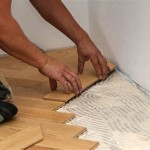Can You Put Laminate Flooring Over Tiles With Underfloor Heating?
The question of installing laminate flooring over existing tiles that incorporate underfloor heating is a common one for homeowners undertaking renovations. The answer is not a straightforward "yes" or "no". A successful installation requires careful consideration of several factors, including the type of underfloor heating system, the condition of the existing tiles, the compatibility of the laminate flooring, and adherence to manufacturer guidelines. Ignoring these considerations can lead to reduced heating efficiency, damage to the flooring, or even system failure.
The appeal of laying laminate directly overtiles is understandable. It avoids the messy and labour-intensive process of removing the old tiles, saving both time and money. However, it is crucial to assess the feasibility of this approach thoroughly before proceeding. A failure to do so can ultimately lead to more significant expenses and complications in the long run. This article explores the key aspects to consider when contemplating this type of installation, offering guidance on how to navigate the challenges and ensure a successful outcome.
Assessing the Underfloor Heating System
The first and perhaps most critical step is to determine the type of underfloor heating system installed. There are generally two main types: electric and hydronic (water-based). Electric systems typically consist of heating cables or mats embedded within the floor structure. Hydronic systems, on the other hand, use pipes to circulate heated water. Each type presents different challenges and considerations when overlaying with laminate flooring.
Electric underfloor heating systems generally respond more quickly to changes in temperature. However, they can also generate higher surface temperatures than hydronic systems. This is a crucial factor to consider when selecting laminate flooring, as excessive heat can cause warping, delamination, or other forms of damage. It is essential to consult the laminate flooring manufacturer's specifications regarding maximum operating temperatures and suitability for use with electric underfloor heating.
Hydronic underfloor heating systems tend to be more energy-efficient and provide a more consistent and even heat distribution. They also operate at lower temperatures, which can be advantageous when overlaying with laminate flooring. However, the presence of pipes beneath the tiles can create unevenness or require specific preparations to ensure a level and stable surface for the laminate. Furthermore, the added insulation of the tiles and laminate can slightly reduce the responsiveness of the heating system.
Regardless of the type of underfloor heating system, it is crucial to ensure that the system is functioning correctly before installing the laminate flooring. Any existing issues with the heating system must be addressed to prevent future problems that could require removing the newly installed floor.
Preparing the Existing Tile Surface
The condition of the existing tile surface is another significant factor that influences the success of the laminate flooring installation. The tiles must be structurally sound, level, and free from significant cracks or damage. Any loose or broken tiles should be repaired or replaced before proceeding.
Uneven tiles can create an unstable base for the laminate flooring, leading to premature wear and tear, creaking, or even damage to the locking mechanisms. Ideally, the tile surface should be as flat as possible. Minor imperfections can often be addressed with a self-leveling compound, which fills in low spots and creates a smooth, even surface. It is crucial to choose a self-leveling compound that is compatible with underfloor heating systems and designed for use over tiles.
Furthermore, the tile surface should be thoroughly cleaned to remove any dirt, grease, or adhesive residue. This ensures proper adhesion of the underlayment or any bonding agents used. A degreasing cleaner is typically recommended for this purpose, followed by a clean water rinse to remove any remaining residue.
In some cases, it may be necessary to roughen the surface of the tiles to improve adhesion. This can be achieved through light sanding or the application of a bonding primer designed for non-porous surfaces. The specific method will depend on the type of tiles and the manufacturer's recommendations for the underlayment or adhesive being used.
Selecting the Appropriate Laminate Flooring and Underlayment
Choosing the right laminate flooring is crucial for successful installation over tiles with underfloor heating. The laminate should be specifically designed for use with underfloor heating systems. This usually means it has a lower thermal resistance, allowing heat to transfer more efficiently through the floor and into the room. The thermal resistance, often expressed as an R-value or tog rating, should be clearly stated by the manufacturer. A lower R-value or tog rating indicates better heat conductivity.
The thickness of the laminate flooring is also a consideration. Thicker laminates generally provide better sound insulation and can be more durable, but they may also have a higher thermal resistance. It is important to strike a balance between these factors, considering the specific needs and preferences of the homeowner.
The underlayment plays a vital role in cushioning the laminate flooring, reducing noise, and providing insulation. However, when installing over underfloor heating, it is essential to choose an underlayment specifically designed for this purpose. These underlayments typically have perforations or channels that allow heat to pass through more easily. Standard underlayments may act as insulators, hindering the efficiency of the underfloor heating system.
Pay close attention to the manufacturer's recommendations for both the laminate flooring and the underlayment. Ensure that both products are compatible with underfloor heating systems and that the combined thermal resistance meets the system's requirements. Ignoring these recommendations can lead to reduced heating efficiency, damage to the flooring, or even void the warranty.
In addition to thermal resistance, consider the overall quality and durability of the laminate flooring. Choose a laminate with a high AC (Abrasion Class) rating, especially in high-traffic areas. This rating indicates the laminate's resistance to wear and tear, ensuring a longer lifespan.
Finally, consider the aesthetics of the laminate flooring. Choose a style and color that complements the existing décor and provides the desired look and feel for the room. Samples can be obtained from most flooring retailers to help visualize how the laminate will look in the space.
Installation Considerations and Best Practices
Proper installation is essential for ensuring the longevity and performance of the laminate flooring. Before starting, carefully read and follow the manufacturer's instructions for both the laminate flooring and the underlayment. These instructions often contain specific guidelines for installation over underfloor heating systems.
Acclimatization is a crucial step that is often overlooked. Before installation, the laminate flooring should be allowed to acclimatize to the room's temperature and humidity for at least 48 hours. This allows the laminate to expand or contract to its natural state, minimizing the risk of warping or buckling after installation.
Leave an expansion gap around the perimeter of the room and around any fixed objects, such as pipes or door frames. This gap allows the laminate flooring to expand and contract with temperature changes without putting pressure on the surrounding walls or objects. The recommended expansion gap size is typically specified by the manufacturer.
When installing click-lock laminate flooring, ensure that the planks are properly engaged and locked together. Use a tapping block and a rubber mallet to gently tap the planks into place, avoiding damage to the locking mechanisms. If any planks are damaged during installation, they should be replaced immediately.
After installation, gradually increase the temperature of the underfloor heating system over several days. Avoid sudden temperature spikes, as this can cause the laminate flooring to expand or contract too quickly, potentially leading to damage. Regularly monitor the floor's surface temperature and adjust the heating system accordingly. A surface thermometer can be a useful tool for this purpose.
Regular maintenance is essential for preserving the appearance and performance of the laminate flooring. Clean the floor regularly with a damp mop and a pH-neutral cleaner specifically designed for laminate flooring. Avoid using excessive water, as this can damage the laminate. Protect the floor from scratches and scuffs by using furniture pads and avoiding the use of abrasive cleaners.
In conclusion, installing laminate flooring over tiles with underfloor heating is possible, but it requires careful planning, preparation, and execution. By considering the type of underfloor heating system, preparing the existing tile surface, selecting the appropriate laminate flooring and underlayment, and following proper installation guidelines, homeowners can achieve a successful and long-lasting installation.

Installing Laminate Flooring Over Asbestos Tiles The Money Pit

Guide To Choosing The Best Flooring For Underfloor Heating Exterior Solutions

Choosing The Best Flooring For Underfloor Heating Luxury

How To Install Radiant Floor Heating Under Luxury Vinyl Tile

Can You Put Laminate Over Tile Answered Floortheory

Luxury Vinyl Tiles Fitted Over Underfloor Heating Cheadle Floors Floor Layer Manchester

Electric In Floor Heating For Laminate Flooring

Underfloor Heating Foil Kits Living Heat

How Do I Pair A Wood Floor With Underfloor Heating Greyspace Flooring

Heated Vinyl Plank Flooring Everything You Need To Know
Related Posts








